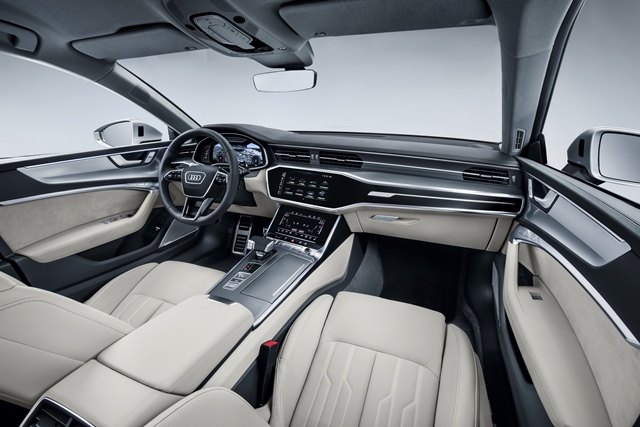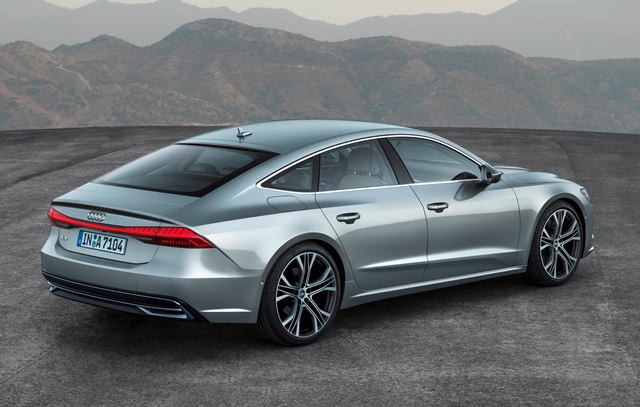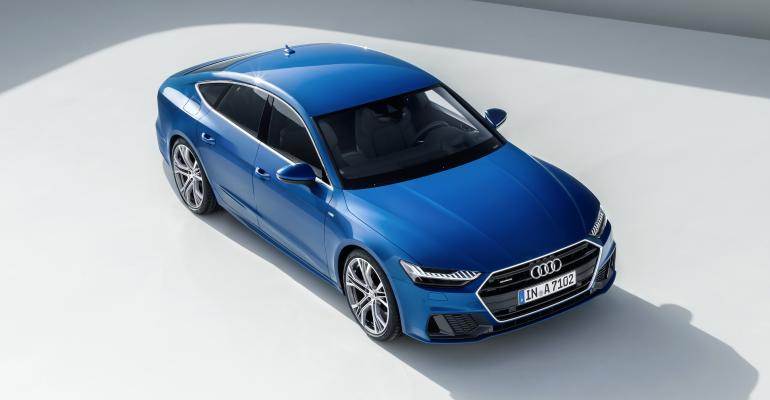INGOLSTADT, Germany – The second-generation Audi A7 is unveiled ahead of the new luxury-class liftback’s public premiere at the 2017 Los Angeles auto show in late November.
The new Audi is planned to reach North American dealers by mid-2018. It sports a sharp new exterior design, a 48V electrical system, new drivetrains with mild-hybrid properties for added fuel savings as well as a steel and aluminum body structure, a reworked chassis featuring 4-wheel steering and numerous digital interior functions as part of a complete engineering overhaul. Competitors include the BMW 6-Series Gran Turismo and Mercedes-Benz CLS.
Along with the latest A8, the ’18-model-year A7 represents somewhat of a new beginning for Audi following the reputation-shredding consequences of parent company Volkswagen’s Dieselgate affair. Initially approved for production in 2014 by Audi boss Rupert Stadler, the new car has suffered a complicated start to life with development completed under three different R&D chiefs: Ulrich Hackenberg, Stefan Knirsch and Peter Mertens.
As with its larger upper-luxury-sedan sibling, though, Audi is adamant the A7 sets new class standards, most notably in refinement, which it says results in outstanding long-distance cruise traits. However, it also is touting the new liftback’s digital interior as being central to its appeal. And with just one model planned for production from the outset, the A7 55 TFSI pictured here officially for the first time, it also appears Audi is taking necessary steps to ensure a gradual ramp-up in volume and quality levels are up to scratch during the initial build phase.
Stylistically, the new A7 continues the theme established with the first-generation model launched in 2010, but with tauter surfacing and crisper forms providing it with fresh visual appeal. The 5-door layout remains; the cabin doors once again are frameless, while the large liftgate is hinged from above the rear window to provide unimpeded access to the cargo area.
The front end, dominated by the latest evolution of Audi’s single-frame grille as seen on the recent A8, is highly reminiscent of that which graced the German car maker’s Prologue concept car displayed at the 2014 Los Angeles auto show. It is set within a heavily structured front bumper and is bookmarked by angular headlamps sporting distinctive LED graphics in one of three different designs that taper back within the leading part of the front fenders.
Farther back are pronounced front wheel arches, a relatively shallow 6-window glasshouse, heavy swage lines within the lower sections of the doors and a roofline that slopes heavily toward the rear, all in keeping with the original A7.

At the rear, Audi gives its latest model an active spoiler element. Integrated into the trailing edge of the liftgate, it deploys at speeds above 75 mph (120 km/h) to increase downforce on the rear axle for added high-speed stability. The most dominant styling feature, however, is the full-width taillamp treatment; the two taillamps receive 13 individual elements and are joined by an illuminated light bar that stretches across the rear of the trunklid.
For those seeking a more sporting touch, Audi intends to offer the new A7 with an optional S line styling package from the outset of U.K. sales. It further hones the appearance, with a high-gloss black treatment brought to the grille insert and front air ducts as well as the sills and rear diffuser.
At 195.6 ins. (4,968 mm) in length, 75.1 ins. (1,908 mm) in width and 56.0 ins. (1,422 mm) in height, the new Audi is 0.6 in. (15 mm) shorter, a scant 0.1 in. (2.5 mm) wider and a similar 0.1 in. higher than the first-generation A7 introduced in 2010.
Based on the latest evolution of Audi’s MLB platform, it also adopts a 0.5-in. (13-mm) longer wheelbase than its predecessor at 115.1 ins. (2,924 mm).
A7, Siblings Follow Concept's Interior-Design Lead
The interior of the new A7 follows the lead of the latest A8, with a contemporary design closely modeled on that first revealed on the Prologue concept car and to be featured on other models as well, including next year’s fifth-generation A6.
Audi says four values characterize the cabin of its new grand tourer: progressiveness, sportiness, intuitiveness and sophistication.
Key features include a 12.3-in. (31-cm) digital instrument display. It is combined with a 10.1-in. (26-cm) multimedia infotainment display integrated within the center of the dashboard fascia and an 8.6-in. (22-cm) display unit mounted lower down at the base of the center console. Both offer standard touch control, with both haptic and acoustic feedback qualities.
The adoption of touch-sensitive displays for all the major functions gives the dashboard a clean and uncluttered look devoid of traditional manual controls. The stubby gear lever, meanwhile, is designed to allow the driver to rest his wrist on the horizontal handle to ease the touch operation of the air conditioning and other functions, according to Audi.
Up front, new seats are claimed to offer added levels of comfort, with buyers able to specify multi-adjustable, customized contour seats with both ventilation and massage functions. The rear can be configured either with two individual seats or a two-plus-one layout. Despite the 0.6-in. reduction in the length of the exterior, Audi claims improvements in packaging have added 0.8 in. (20 mm) of length within the interior, and with it increased rear legroom.
The nominal 18.9-cu.-ft. (535-L) trunk capacity of the original A7 is retained, although Audi says the cargo area has been redesigned for improved utilization of space. The tailgate is manually operated, though buyers can choose an optional foot-operated sensor that provides automatic opening and closing.

Optional equipment includes Matrix LED headlamps with laser projector units, a head-up display unit, voice control, a choice of four different sound systems, including a top-of-the-line Bang & Olufsen unit offering 3-D surround-sound qualities to the rear seat, remote-parking pilot and, from 2018 onwards, remote garage pilot – the latter of which autonomously maneuvers the A7 into and out of parking spaces or garage without needing a driver behind the steering wheel.
The garage pilot is among a number of autonomous-driving functions. Depending on the equipment level specified by the buyer, the new A7 can feature up to five radar sensors, five cameras, 12 ultrasonic sensors and a laser scanner. They are networked by a so-called zFas central driver-assistance controller. All told, the new Audi features 39 different driver assistant systems, both as standard and optional.
The second-generation A7 will be launched with just a single engine, although others, including both 4- and 6-cyl. gasoline and diesel units, are to be added to the lineup as production of the new 5-door ramps up at Audi’s plant in Neckarsulm, Germany.
The turbocharged 3.0L V-6 gasoline unit comes as standard with a new belt-drive alternator, lithium-ion battery and 48V electric architecture to provide it with mild-hybrid properties. At speeds between 34 and 100 mph (55 and 161 km/h), it can coast with the combustion process idled for added fuel savings on extended periods of trailing throttle.
It also has a stop/start function that shuts down the engine below 14 mph (23 km/h) when rolling up to traffic lights. In combination with a front camera, the engine is restarted as soon as the car ahead begins to move or, alternatively, when the driver activates the throttle once more.
The successor to the earlier supercharged 3.0L V-6 offered in the first-generation A7 produces 340 hp and 369 lb.-ft. (500 Nm) of torque. Drive is channeled through a standard 7-speed S-tronic dual-clutch gearbox and the latest iteration of Audi’s quattro all-wheel-drive system that only activates the rear wheels when it detects added traction is required.
The new engine provides the initial A7 55 TFSI model with a claimed 0-62 mph (0-100 km/h) time of 5.3 seconds and electronically limited top speed of 155 mph (250 km/h), with fuel consumption pegged at 34.6 mpg (6.8 L/100 km) on the European test cycle.




